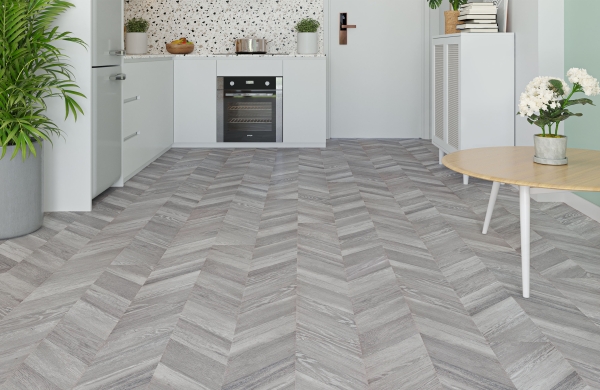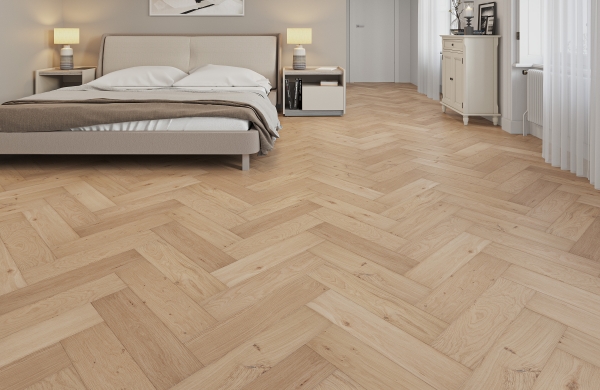What is parquet flooring?
Parquet is a traditional style of flooring created by laying planks in different patterns, resulting in eye-catching geometric designs.
Originally parquet was created with solid wood flooring blocks, but today it’s available in a range of different types of flooring, including engineered wood, LVT and laminate.
What are the different patterns of parquet?
The three main parquet patterns are Herringbone, Chevron and Versailles.
Herringbone flooring is created by laying rectangular planks in a staggered zigzag pattern. The quickest way of identifying herringbone is, as the name suggests, the pattern that resembles a fish skeleton.
Chevron flooring is achieved by laying rectangular planks in a zigzag pattern that forms a sharp point. The key identifier of a chevron floor is the pattern that looks like the chevron signs you’d find on a motorway.
Versailles flooring is made up of a pattern of squares which incorporate diamond, triangle and diagonal patterns inside them.
Does parquet flooring make a room look bigger or smaller?
One of the benefits of parquet flooring is that it can make your room feel bigger or longer than it really is.
When laid parallel to the longest wall in the room both herringbone and chevron flooring create the illusion of more space. Wide planks are especially effective at tricking the mind as they offer minimal definition which makes the room look less cluttered.
How long does parquet last?
How long a parquet floor lasts will depend on the kind of floor it is and how well it’s maintained.
Solid wood flooring can last for up to 100 years, provided it’s taken care of properly, while engineered wood flooring has a shorter life expectancy of around 60 years.
LVT SPC flooring is expected to last approximately 25-30 years and laminate has the shortest lifespan, around 15-25 years.
No matter what kind of floor you choose, proper maintenance is crucial to extending its life. Check the installation guide that comes with your floor for instructions on keeping it in tip-top shape or contact our fabulous customer service team.
How much does parquet flooring cost?
The cost of parquet flooring will vary depending on the type of flooring you choose.
Solid wood parquet is the most expensive, although it has the benefit of being the most long-lasting, making it a fantastic investment.
Solid wood’s budget-friendly counterpart is engineered wood and is the perfect compromise if you want the look of solid wood parquet at a lower price.
The most affordable parquet flooring options are LVT and laminate. However, neither are as long-lasting as solid and engineered wood.
Does parquet flooring need underlay?
Whether your parquet floor needs underlay will depend on the type of floor you’re installing, and the installation method used. We recommend checking the spec and installation guide for your floor to find out if you need to buy underlay.
How much does it cost to lay parquet flooring in the UK?
Laying wood parquet flooring is a time-consuming job, taking roughly 2-5 days to complete, depending on the size of your room and how much subfloor preparation is needed.
Professional fitters charge an average of £100-£200 per day for fitting wood parquet floors, although this may vary depending on where in the UK you live.
The cost of fitting an LVT or laminate parquet floor should be much lower than that of wood parquet. However, we recommend getting a quote from several reputable fitters before you decide what type of floor to buy.
Can I lay my own parquet floor?
You can absolutely lay your own parquet floor if you have all the tools for the job. However, it can be a tricky process, so it’s important to read your installation guide carefully to make sure you get it right!
If you’re in any doubt about laying your parquet floor, we recommend hiring a professional fitter to complete the job or to advise you on how to do it yourself.
What’s the cleaning method for parquet?
The cleaning method you should use for your parquet flooring will depend on the type of floor you choose.
Solid and engineered wood floors should be swept or vacuumed daily to remove any dirt that’s made its way indoors. A weekly once-over with a damp mop will keep your wood flooring clean and hygienic.
LVT and laminate flooring is lower maintenance than wood, so a weekly or twice weekly sweep or vacuum will keep it looking its best. Mopping should be carried out once a week; use a damp microfibre mop and check the manufacturer’s instructions for the recommended cleaning solution.




































